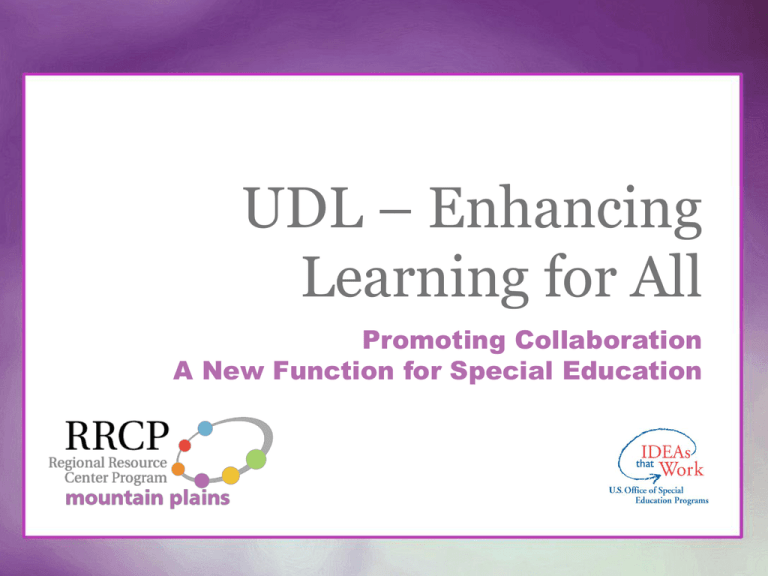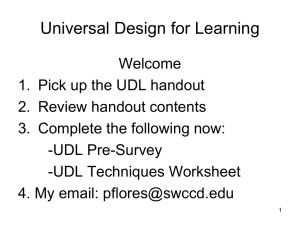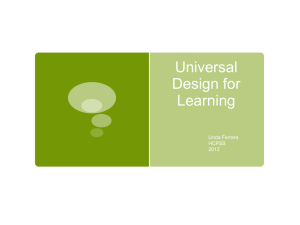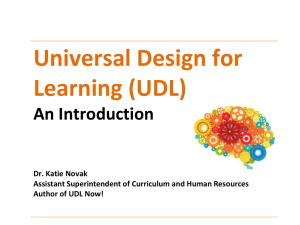UDL – Enhancing Learning for All
advertisement

UDL – Enhancing Learning for All Promoting Collaboration A New Function for Special Education Getting Off To a Good Start Play is the exultation of the possible. - Martin Buber They were in the house alone... Just the two of them. It was a cold, dark, stormy night. The storm had come quickly and each time the thunder boomed he watched her jump. She looked across the room and admired his strong appearance...and wished that he would take her in his arms, comfort her and protect her from the storm. She wanted that...more than anything. Suddenly, with a pop, the power went out... she screamed...he raced to the sofa where she was cowering. He didn't hesitate to pull her into his arms. He knew this was a forbidden union and expected her to pull back. He was surprised when she didn't resist but instead clung to him. The storm raged on...as did their growing passion and there came a moment when each knew that they had to be together. They knew it was wrong... Their families would never understand... So consumed were they in their passion that they heard no opening of doors...just the faint click of a camera...... Have you smiled today? Let us show you how . . . Always Remember How To Smile!!! Life may not be the party I had hoped for........... But while I'm here I might just as well listen to the music and dance! Make Today Count Stay in curiosity Listen for nuance Share your questions and concerns Don’t take yourself or others too seriously Credits and Thanks www.udlcenter.org Those willing to post PowerPoints publicly – – – – – – Jenna Gravel Patti Ralabate Lisa Thomas Elizabeth Dalton Paul Sherlock CAST (National Center on Universal Design for Learning) Collaboration and UDL? Why? Accessing the general curriculum Improving instruction and learning Improving results Some people spend their time looking forward mostly to the past. - John Oshborne You don’t have to do it. Survival is not compulsory. - Deming The future is now . . . http://www.youtube.com/ watch?v=Fnh9q_cQcUE &feature=related Which is closer to your classrooms? But . . . . This is not a session on technology (per se) This is a session on access to learning through instruction based on UDL Today’s Session at a Glance What is UDL? Principles of UDL – What are they? – Examples of each UDL Guidelines Tools & Resources What is UDL? A way to provide learning opportunities in the general education curriculum that are: INCLUSIVE and EFFECTIVE FOR ALL Universal Design for Learning Born from architectural world Intended to design and construct equal access facilities Concept transferred to education Civil Rights Legacy – Universal Design Universal Design: Access for everyone! Old design: Some are denied Universal Design “Consider the needs of the broadest possible range of users from the beginning.” — Ron Mace Universal design principles Not an afterthought: Full access is designed from the outset More cost-effective than retrofitting More elegant and easy-to-use . . . I have seen that in any great undertaking it is not enough for a man to depend simply upon himself. -Lone Man, Teton Sioux 1. Think and list – all of the things that you come across or use in your daily life that make it easier for you to function. (1min) 2. Share and combine lists with two colleagues. (3 min) 3. Count up items on your list. 4. Who has the most items? Universal design (UD) examples Assistive Technology Universal Design Assistive Technology Ramps and curb cuts Digital books with text-tospeech TV and video captioning Easy-grip tools Electric doors Highlight text Minimize distraction Universal design for learning Combines new insights from brain research about the nature of learner differences… …with a century of best practices in progressive education. HTTP://WWW.NASDSE.ORG/ Universal Design for Learning BACKGROUND AND PRINCIPLES Defining UDL Principles laid down by CAST in the 1990s Federal support for UDL research, dissemination since 1999 Defined by federal statute in 2008 Higher Education Opportunity Act Universal Design for learning “A scientifically valid framework for guiding educational practice” (Source: Higher Education Opportunity Act of 2008) Universal Design for Learning… reduces barriers in instruction provides appropriate accommodations [and] supports maintains high achievement expectations (Source: Higher Education Opportunity Act of 2008) Universal Design for Learning Eliminating or reducing barriers to academic success for all students Valuing diversity in the classroom through proactive design of inclusive curriculum Universal Design for Learning Increasing options for access Increasing options for participation Increasing options for demonstrating learning Leading to increased equitable access to the general curriculum – Higher achievement – More graduation – Less drop out Universal Design for Learning… “Provides flexibility in the ways – Information is presented – Students respond or demonstrate knowledge and skills – Students are engaged” (Source: Higher Education Opportunity Act of 2008) Three Fundamental Principles Multiple Means of Representation – To increase recognition Multiple Means of Expression – To expand purposeful output Multiple Means of Engagement – To enhance involvement What are the UDL Principles? In each area of the curriculum provide varied and flexible options for: – – – Representing information Action and expression Engagement Universal Design for Learning Guidelines Recognition through Representation Provide options for perception Provide options for language, mathematical expressions, and symbols Provide options for comprehension Perception – Customized displays – Auditory alternatives – Visual alternatives Expression – Vocabulary and symbols – Syntax and structure – Decoding – Understanding – Multiple illustrations Comprehension – Background knowledge – Patterns and relationships – Information processing – Transfer and generalization Multiple Representations of Information Examples – Offer text-to-speech, video, audio, and other multimedia; integrate assistive technologies into learning environment – Provide vocabulary support and background knowledge – Highlight critical features & main ideas Exploring the Three Principles http://www.udlcenter.org/aboutu dl/udlguidelines Does Not Have to Be Complex Read aloud Highlight phrases Listen to audiotapes Text-to-speech What are your ideas? – Generate examples of how you have represented information in alternative formats. – Generate new and creative possibilities. Provide Multiple Means for Action and Expression Options for physical action Options for expression and communication Options for executive functions Physical action – Vary response and navigation – Optimize tools and technologies Expression and communication – Multiple media – Tools for construction and composition – Graduated levels of support Executive functions – Goal setting – Planning and strategy development – Managing information and resources – Enhance monitoring progress Multiple Means of Action and Expression Examples – Let students show what they know with voice recording, graphic displays, performance, etc. – Provide models of expert performance – Offer executive-function supports such as graphic organizers, outlines, etc. Exploring the Three Principles http://www.udlcenter.org/aboutu dl/udlguidelines Does Not Have to Be Complex Voice recording Graphic displays Graphic organizers Dance or movement Embedded prompts Checklists Spellcheck Story webs and outlines Sentence starters What are your ideas? – Generate examples of how you have allowed multiple means for action and expression. – Generate new and creative possibilities. Provide Multiple Means for Engagement Options for recruiting interest Options for sustaining effort and persistence Recruiting Interest – – – Options for selfregulation Individual choice and autonomy Relevance, value and authenticity Minimize threats and distractions Sustaining effort and persistence – Heighten salience of goals and objectives – Vary demands and resources – Foster collaboration and community – Increase mastery-oriented feedback Self-Regulation – Promote expectations and beliefs Exploring the Three Principles http://www.udlcenter.org/aboutu dl/udlguidelines Does Not Have to Be Complex Flexibility in use of tools What are your Provide choice in ideas? mode of expression – Generate examples of how you provided Connect to community multiple means for opportunities engagement. Use flexible grouping – Generate new and strategies creative possibilities. Create positive school culture Peer tutoring Differentiated goals Multiple Means of Engagement Examples – Vary levels of challenge and support to prevent frustration or boredom – Tie work to real-world examples – Where possible, give choices – Teach self-assessment and reflection – Implement school-wide positive behavioral interventions and support Positive Behavioral Interventions and Supports: Managing Student Behavior “Creating classroom norms, expectations and rules are a golden opportunity to establish and sustain student engagement, use it.” - Dr. Mary Magee Quinn Summing it all up The old days will not be again, even as a man will never again be a child. (Dakota) http://www.youtub e.com/watch?v=1 heHn7j_AEY&feat ure=related You are shaping the future! UDL applies to the whole curriculum Goals Traditional – Learning goals may get skewed by the inflexible ways and means of achieving them. UDL – Learning goals are attained in many individualized ways, by many customized means. Materials Traditional – Mostly print and everyone gets the same materials – Few options UDL – Variety of materials and formats to reach learners with diverse abilities, styles, and needs equally well. Methods Traditional – Teacher centered (lecture) – Homogeneous grouping – Burden on student to adapt to “get it” UDL – Interactivity – Heterogeneous grouping – Rich supports for understanding, independent learning Assessment Traditional – Confuse goals with means. – Summative—when it’s too late to adjust instruction! UDL – Many positive means as long as they measure learning! – Supports instructional improvement. UDL Unplugged The Role of Technology in UDL http://www.udlcenter.org/resource_libr ary/articles/udlunplugged The Seed Lesson – Example lesson illustrating how all principles of UDL can be met even with limited technology With UDL, more students are… Engaged in their own education Learning at greater breadth and depth Achieving at higher levels Motivated to continue learning More educators are… Teaching effectively in classrooms with diverse student needs Spending more time on instruction and facilitating learning Helping ALL learners succeed Federal supports for UDL Statutes and regulations – – – – No Child Left Behind Act (NCLB) Individuals with Disabilities Education Act (IDEA) National Instructional Materials Accessibility Standard (NIMAS) Higher Education Opportunity Act (HEOA) Federal investment in UDL US Department of Education – – – Office of Special Education Programs Institute for Education Sciences Office of Postsecondary Education National Science Foundation What can you do now? Apply UDL to your instruction Demand universally-designed products Share your UDL resources and lesson plans with others Advocate curriculum adoption policies that require UDL principles For More Information OSEP Ideas that Work - UDL Toolkit http://www.osepideasthatwork.org/udl/ National UDL Task Force www.udl4allstudents.org CAST www.cast.org National UDL Center www.udlcenter.org Thank You! May you be one who makes things happen for the students you teach. May you have a wonderful and successful school year.




